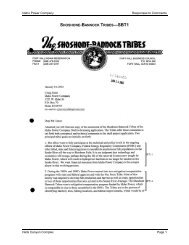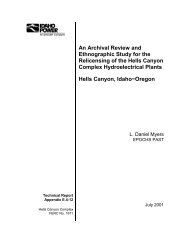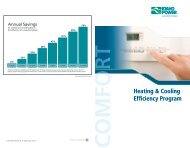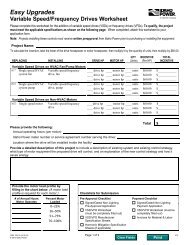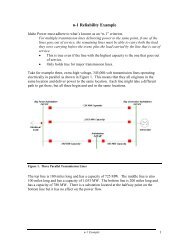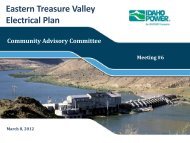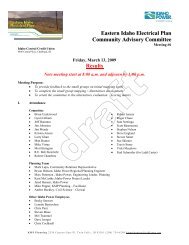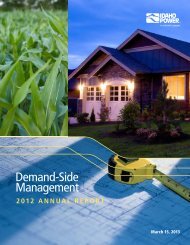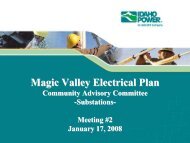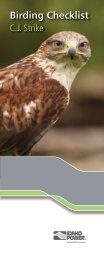Assessment of Chukar and Gray Partridge Populations - Idaho Power
Assessment of Chukar and Gray Partridge Populations - Idaho Power
Assessment of Chukar and Gray Partridge Populations - Idaho Power
- No tags were found...
You also want an ePaper? Increase the reach of your titles
YUMPU automatically turns print PDFs into web optimized ePapers that Google loves.
Hells Canyon <strong>Chukar</strong> <strong>and</strong> <strong>Gray</strong> <strong>Partridge</strong> Report, Ratti <strong>and</strong> Giudice 7ASSESSMENT OF CHUKAR AND GRAY PARTRIDGE POPULATIONSAND HABITAT IN HELLS CANYON1. IntroductionIn June 1999, Dr. John Ratti (Department <strong>of</strong> Fish <strong>and</strong> Wildlife Resources, University <strong>of</strong><strong>Idaho</strong>) responded to a request for proposal from <strong>Idaho</strong> <strong>Power</strong> Company to conduct an“<strong>Assessment</strong> <strong>of</strong> <strong>Chukar</strong> <strong>and</strong> <strong>Gray</strong> <strong>Partridge</strong> <strong>Populations</strong> <strong>and</strong> Habitat in Hell Canyon.” InSeptember 1999 a contract was signed between the University <strong>of</strong> <strong>Idaho</strong> <strong>and</strong> <strong>Idaho</strong> <strong>Power</strong>Company for this assessment to be conducted by Dr. Ratti. Project completion (i.e., draft reportdue) was scheduled for 1 April 2001. Author resumes are in Appendix A.Objectives <strong>of</strong> the study were to conduct a review <strong>and</strong> evaluation <strong>of</strong> chukar (Alectorischukar) <strong>and</strong> gray partridge (Perdix perdix) populations <strong>and</strong> habitat in Hells Canyon to: 1)characterize the social <strong>and</strong> ecological significance, 2) describe natural- <strong>and</strong> life-historyrequirements, 3) assess the current status <strong>of</strong> populations <strong>and</strong> habitat quality, 4) identify therelative significance <strong>of</strong> natural <strong>and</strong> anthropogenic limiting factors as they currently affect habitatquality <strong>and</strong> population stability, 5) project how habitat quality <strong>and</strong> population stability maychange in the future, <strong>and</strong> 6) suggest opportunities for mitigating limiting factors in order tobenefit these 2 species in the evaluation area.2. Study AreaThis review focused on the area surrounding the 3-dam complex <strong>and</strong> correspondingreservoir system that comprises <strong>Idaho</strong> <strong>Power</strong> Company’s Hells Canyon Hydroelectric Complex.Longitudinally, the evaluation area extends north from approximately Weiser, <strong>Idaho</strong> at river mile351 on the Snake River to Hells Canyon Dam at river mile 247 (Figure 1). Laterally, theevaluation area extended from the canyon rim in Oregon to the rim in <strong>Idaho</strong> (Figure 1). Thisarea encompasses approximately 1,600 km 2 .3.1. Literature Review3. MethodsWe attempted to locate all literature associated with the biology <strong>and</strong> ecology <strong>of</strong> chukar<strong>and</strong> gray partridge in North America, with emphasis on Hells Canyon <strong>and</strong> the IntermountainWest. Our search for literature included: 1) computerized literature-search services, 2) use <strong>of</strong> theUniversity <strong>of</strong> <strong>Idaho</strong> special-documents library (e.g., government reports), 3) personal contactswith state <strong>and</strong> federal biologists with experience or responsibility in or adjacent to Hells Canyon,<strong>and</strong> 4) review <strong>of</strong> literature cited in key publications on the target species.



